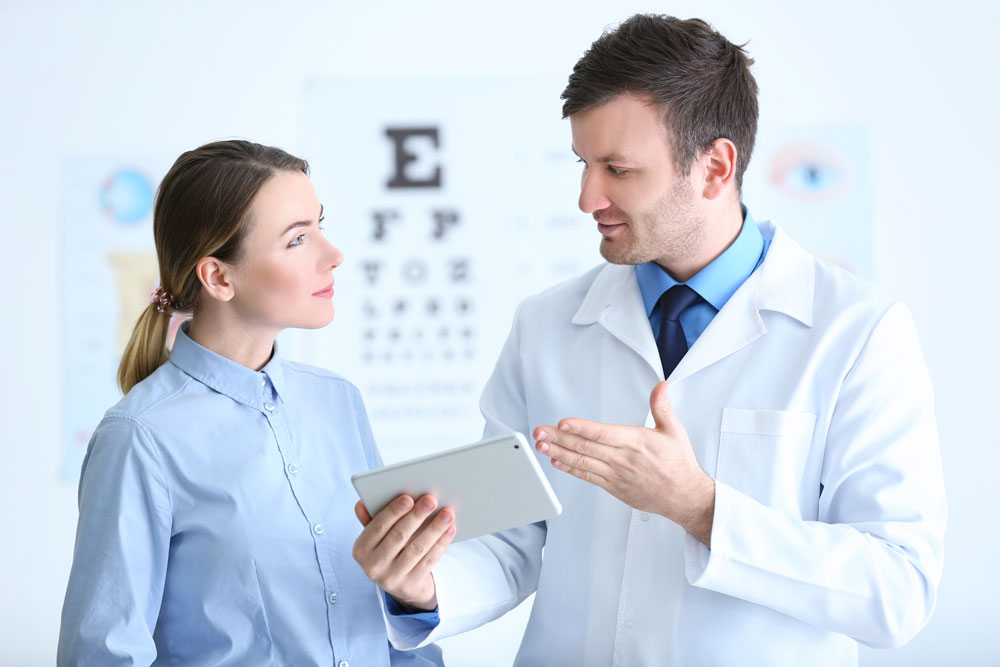Blog
Ensuring a Clear Path to Visual Freedom — Why We Treat Dry Eye Disease Before LASIK

If you’re considering LASIK, you’re likely excited about the prospect of achieving clear vision and reducing your reliance on eyewear, like glasses or contact lenses. LASIK, a popular refractive surgery, has transformed the lives of millions, but before taking the plunge, it’s crucial to address a common eye condition that could affect your LASIK experience — dry eye disease.
What Is LASIK?
Laser assisted in situ keratomileusis, commonly known as LASIK, is a lifechanging refractive eye surgery that can enhance your eyesight if you have myopia (nearsightedness), hyperopia (farsightedness), and astigmatism. LASIK is one of the most common and reliable corrective surgeries performed today and is known for helping to improve the quality of life for many patients. During LASIK surgery, our eye doctors will use lasers to create a small opening in your cornea to reshape it, eliminating refractive errors and creating incredible results.
Understanding Dry Eye Disease and Its Impact
Dry eye disease is a common, yet uncomfortable condition where your eyes either don’t produce enough tears or produce low-quality tears that evaporate quickly. Dry eye disease symptoms can range from mild irritation to discomfort, redness, and blurred vision. Several factors contribute to the development of dry eye disease, including arid environments, extended digital screen use, and complications from certain eye surgeries.
When preparing for LASIK surgery, dry eye disease becomes a crucial consideration due to its potential impact on the surgical outcomes. LASIK works by reshaping the cornea, and for a successful surgery, the cornea needs to heal efficiently and without complications after the procedure. However, untreated dry eye disease can jeopardize this healing process and lead to various issues.
The Relationship Between Dry Eye Disease and LASIK
The foundation of a successful LASIK procedure is based on getting precise measurements and readings of your eye and its health before surgery. These measurements determine the necessary corrections and adjustments to make during the procedure, as each patient has their own unique vision needs. However, dry eye disease can disrupt the stability of your tear film and ocular surface, making it challenging to obtain these measurements.
Inaccurate measurements can result in less ideal vision correction outcomes, which can leave patients disappointed with the results. LASIK also involves creating a thin corneal flap that’s repositioned after the cornea is reshaped. This flap needs to heal quickly and securely; however, dry eyes can slow down the healing process, leading to discomfort and an extended recovery period.
Resolving Dry Eye Issues Can Improve LASIK Candidacy
Treating dry eye disease before considering LASIK will enhance your candidacy for the procedure. By stabilizing your tear film and maintaining adequate moisture on the ocular surface, dry eye treatment can improve the accuracy of preoperative measurements. Addressing dry eye disease early also ensures your eyes are in the best possible condition for your LASIK surgery. Preoperative dry eye treatment also promotes a smoother and faster recovery after the procedure, as a well-hydrated eye surface allows for more efficient healing, reducing discomfort and allowing you to enjoy the benefits of LASIK sooner!
Learn more about LASIK and if it’s the right fit for you.
Dry Eye Treatment Options for LASIK Preparation
Before undergoing LASIK, consult with an eye care professional at DLV Vision to assess the root cause of your dry eye condition and explore appropriate treatment options. Some common dry eye treatment methods include:
Artificial Tears: Over the counter or prescription eye drops that mimic natural tears can provide much-needed lubrication and relief from dry eye symptoms.
Punctal Plugs: These small devices are inserted into your tear ducts to slow down tear drainage, keeping the eyes moist for longer periods.
Prescription Medications: In some cases, eye care professionals may prescribe anti-inflammatory eye drops or medications to alleviate dry eye symptoms.
Advanced Dry Eye Treatment Services at DLV Vision
Depending on the root cause of your dry eye disease, you may benefit from more specialized dry eye treatments. Two of our more popular advanced options are:
LipiFlow®
LipiFlow® is an innovative treatment for dry eye patients with inflammation and meibomian gland disorder (MGD). MGD is an underlying cause of dry eye caused by blockage of the meibomian gland, which produces the oil component of your tears — and keeps your tears from evaporating too quickly. LipiFlow® uses controlled, gentle heat to apply pressure to the eyelids, unclogging and restoring proper function to your glands and reducing dry eye symptoms.
Intense Pulsed Light (IPL)
Patients with inflammation and MGD can also potentially benefit from intense pulsed light treatment (IPL). IPL sends controlled pulses of broad-spectrum light into the skin of the area around your eyes, which can reduce inflammation and improve your gland function quickly and painlessly.
Take Care of Your Dry Eye Before Undergoing LASIK
Embarking on the journey to visual freedom through LASIK is exciting, but ensuring the best possible outcomes requires a complete view of your eye health. Treating dry eye disease before undergoing LASIK is a crucial step in mitigating potential risks and enhancing the success of the procedure. At DLV Vision, we prioritize the health and well-being of our patients, providing comprehensive care that includes the treatment of dry eye disease. Schedule a consultation with our experienced eye care professionals to assess your eye health and determine the optimal path to clear vision with LASIK.


